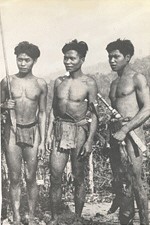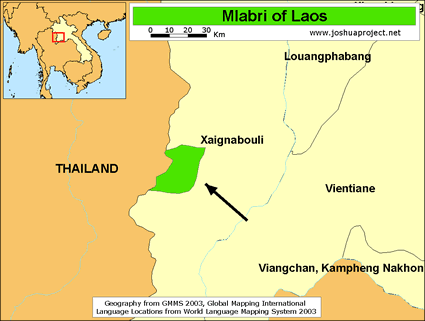Mlabri or Mabri is the self-name of this group. The Lao and Thai call them Kha Tong Luang, which means "slaves of the Yellow Banana Leaves." This name is given to them because of their custom of living in temporary ground-level shelters made of a wooden frame and covered with banana leaves. When the leaves wither and turn yellow the Mlabri abandon their homes and move to a different area to hunt for food. This cycle usually repeats itself every 5-15 days.
There is another group of about 300 people called Kha Tong Luang in Laos, who practice the same customs. They live in remote mountains on the Laos-Vietnam border. The Mlabri and this later group are not linguistically related and are separated by a considerable distance. To complicate matters, the Pakatan in Laos are also labeled Kha Tong Luang by the Lao.
The Mlabri people live in Laos' Phiang District of Xaignabouri Province. Epidemics and a decrease of their resources has almost wiped them out. Others live across the border in Nan and Phrae provinces of Thailand.
Mlabri men wear little clothing, except a small loin-cloth. Their matrilineal social organization allows serial monogamy; a Mlabri woman typically changes mates every five or six years, taking any children from the previous union with her.
After death, the corpse of a Mlabri is placed in the treetops to be devoured by birds.
They are animists who believe they are not entitled to cultivate the land for themselves. They believe in many gods. They believe evil spirits inhabit trees, and fear rainbows, which they believe are monsters who devour human flesh.
There has never been a known Christian among the Mlabri in either Laos or Thailand. Eugene and Mary Long, missionaries with New Tribes Mission, worked selflessly among the Mlabri for more than 20 years in Thailand. Even though they are deeply loved by the Mlabri, none have yet made a decision to follow Christ.
Pray God would help the Mlabri break through the spiritual barriers that prevent them from following Christ.
Ask God to bless and multiply the work of New Tribes Mission among the Mlabri in Thailand.
Pray for an unstoppable movement to Christ among the Mlabri people.
Scripture Prayers for the Mlabri in Laos.
| Profile Source: Joshua Project |












